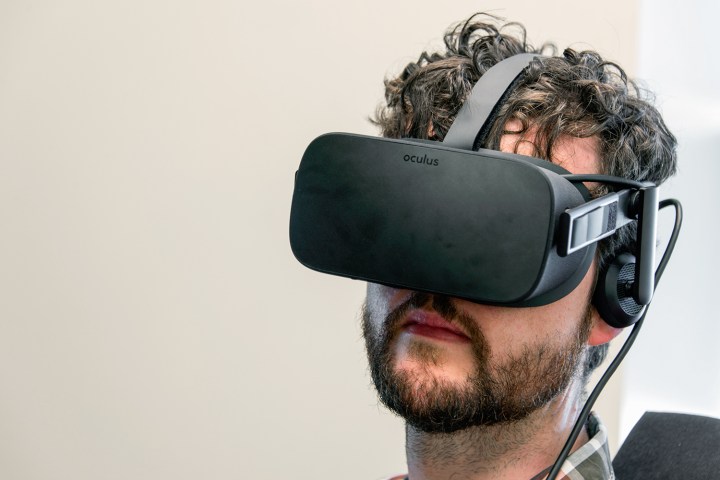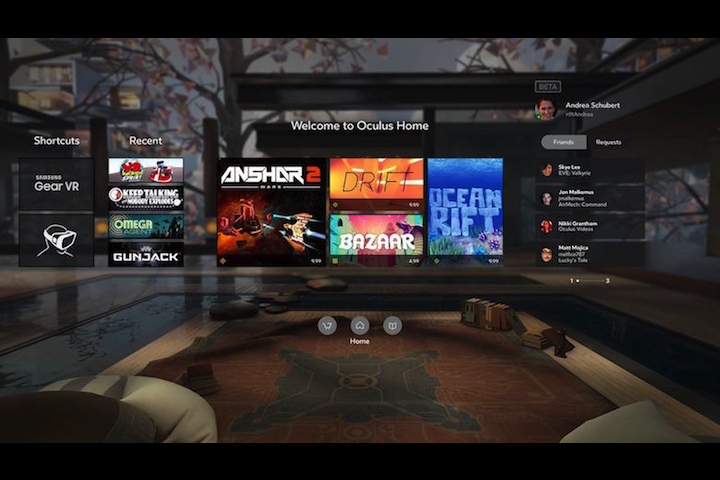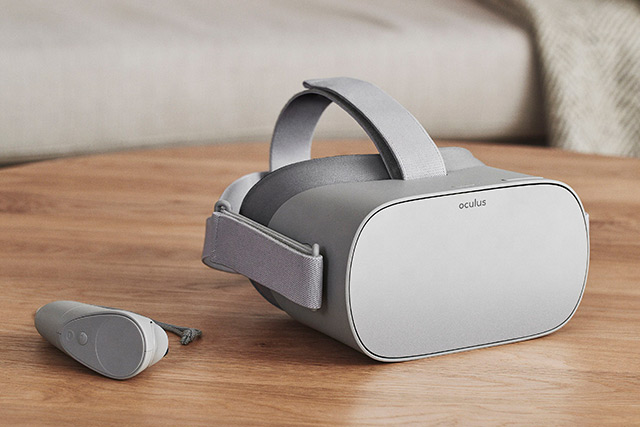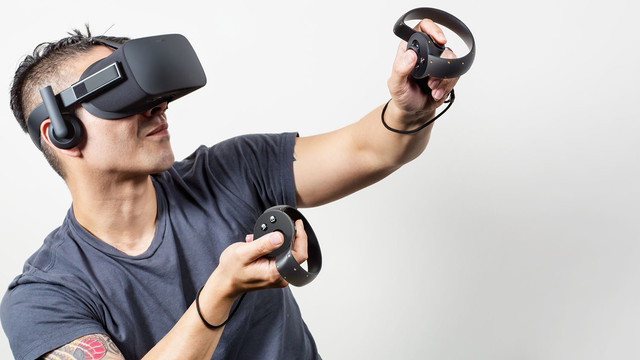
But with the announcement of the new standalone VR headset, the Oculus Go, we’ve had to go back and reconsider whether a mobile setup can really compete with the power of a PC-enabled headset.
In this head to head comparison of the Oculus Rift vs. Oculus Go, we’ll compare Oculus’ two flagship virtual reality offerings to see whether you need to pay for a high-end gaming PC and the higher cost of the standard Rift, or if the new Go headset offers enough on its own to give you a full VR experience.
Specifications
Oculus Rift
|
Oculus Go
|
|
| Display | OLED | LCD, “fast switch” |
| Resolution | 2,160 x 1,200 | 2,560 x 1,440 |
| Refresh Rate | 90Hz | Unknown |
| Software Support | Oculus Home, Steam | Oculus Go, Gear VR |
| Field of view | 110 degrees | 110 degrees |
| Tracking area | 5 x 5 feet (two sensors), 8 x 8 feet (three) | Seated, Standing (inside-out) |
| Built-in audio | Yes | Yes |
| Built-in mic | Yes | Unknown |
| Controller | Oculus Touch, Xbox One controller | Wireless remote |
| Sensors | Accelerometer, gyroscope, magnetometer, Constellation tracking camera. | Accelerometer, gyroscope, magnetometer. |
| Connections | HDMI, USB 2.0, USB 3.0 | 3.5mm audio jack |
| Requirements | NVIDIA GeForce GTX 960 / AMD Radeon RX 470 or greater
Intel Core i3-6100 / AMD FX4350 or greater 8GB+ RAM Compatible HDMI 1.3 video output 2x USB 3.0 ports Windows 7 SP1 or newer |
Nothing, entirely standalone. |
| Price | $400 on sale ($500 after) | $200 (2018 launch) |
| DT review | 3 out of 5 stars | Coming Soon |
Design
Although official specifications for the Oculus Go have yet to be released, we do know a few details about its design that allows us to make some speculative comparisons between it and the Rift. In terms of the basic design layout of the two headsets, they look quite comparable. Both feature a fabric coating over a hard-plastic shell, though we’re told that the Go will feature a “new fabric” that’s more breathable. The new Oculus Go has a soft elastic strap for fitting the display to your head, where the original Rift’s is a mixture of plastic and velcro fabric.
Both in terms of aesthetics and materials, the Oculus Go is immediately reminiscent of something like Google’s Daydream View headset. Like that one, the style is designed be comfortable and approachable for people’s first VR experience. Unlike the Rift, which looks like a piece of sci-fi tech, the Go looks more like something that’s meant to blend in to your living room.
We’ll have to wait to try it on ourselves to report on how it effects comfort, but the new materials should make it easier to swap the headset off and on, which is something that Oculus appears to see as important for its new portable device.
That kind of thinking was present in the choices for audio solution too. Instead of building headphones into the headband like the original Rift, the Oculus Go leverages integrated spatial audio drivers. That means friends and onlookers can hear what you hear and you should still benefit from 3D sound. There’s a 3.5mm connector built into the headset too, for those who want to use their own headphones.
The major design difference between the two headsets though, is that one connects up to your PC and the other doesn’t. The Go doesn’t need a smartphone to run either, so is entirely self-contained and wireless. That does mean though, that it has a micro-computer built into the headset. What that means for weight, performance and battery life, remains to be seen. HTC has a similar standalone headset in the works,
That portable nature and the ease with which it’s designed to be switched between users may make the Oculus Go a great headset for first-time VR users, especially if they’re having a ‘go’ in a group.
Winner: Oculus Go
Visuals
Where the Oculus Rift sports a pair of OLED displays with a combined resolution of 2,160 x 1,200, the Oculus Go sports a singular LCD display with a resolution of 2,560 x 1,440. Although OLED should deliver darker blacks and richer contrast than its LCD counterpart, Oculus claims that it’s employed a “fast switch” panel in the Go, which further improves visual clarity and reduces the screen door effect.

Although there are quite different technologies at play with the displays themselves, Oculus is using a second-generation of its custom fresnel lenses for the Go. Based off of the ones used in the original Rift design, these ones are said to reduce the amount of glare. That was a real problem we found in darker scenes on the Rift, so that’s a welcome improvement if realized in actual use.
As for refresh rate, we don’t know what the Go is capable of just yet. It will likely be 90Hz at a minimum, as that appears to be the comfort point for most VR experiences.
How good games and experiences will actually look on the Go may well depend on how powerful the hardware of the Go headset is. It’s unlikely to be able to hold a candle to a gaming PC, so the Rift is likely to be able to deliver much better visuals, even if its display and lenses are an older technology.
Winner: Draw
Software
As with most hardware platforms, both the Rift and the Go are only as good as the software they can run. While the Rift has access to its own full library of Oculus Home titles (these are our favorites), it can also play many of the hundreds of games and experiences on Steam. In comparison, the Oculus Go will have its own library of supporting games, but will also support much of the Gear VR library at launch.
It’s quite possible that Facebook will use the more entry-level Go headset as its recommended tool for using some of the integrated VR features it’s planning to bring to the social network in the future. The Go could also be Oculus and Facebook’s way of drawing in the iPhone crowd, which currently doesn’t have much access to a VR mobile headset like the Samsung-specific Gear VR.

That should give us an idea of the kinds of games and experiences we can expect on the Oculus Go. Although it will be great for socializing and watching 3D and 360-degree movies, in terms of gaming, its experience will be limited by the capabilities of the headset and its more mobile focus.
Oculus has confirmed that the Go will support two popular game engines — Unity and Unreal Engine — as well as its own proprietary technology. The Rift can support those same engines, as well as the likes of CryEngine.
Winner: Oculus Rift
Tracking and controllers
The Oculus Rift’s tracking solution is very similar to what was used for its earlier developer kit versions. Its Constellation tracking cameras allow for positional movement in six degrees of freedom and with multiple sensors it can offer seated, standing and limited roomscale interaction.
In comparison, the Oculus Go utilizes onboard sensors to detect rotational and orientation tracking. That means you can’t move physically backwards and forwards, but you can tilt from side to side and look around you. It’s three degrees of freedom, which is limited in comparison to the Rift and makes the Go more suited to stationary experiences.
In terms of controllers, the Oculus Rift has arguably one of the best VR controllers right now with Touch. They offer gesture tracking as well as detailed interactions with the user’s hands in the virtual world. The Oculus Go, on the other hand, leverages a wireless remote that is more like an advanced version of the original Rift remote. It features a trigger and touchpad, making it comparable to the Gear VR controller or Daydream controller.
The lack of controller tracking and the limited scope of player tracking and movement, means that the Rift still offers much more freedom than the Go within the virtual world.
Winner: Oculus Rift
Price and availability
Arguably the biggest difference between the Oculus Rift and the Oculus Go is the price tag. On top of the fact that the Rift is double the cost of the Go ($400 vs $200), you also need a pretty powerful PC to run the Rift, which if you don’t already have, will cost you several hundred dollars more.
That makes the Go a much more attractive entry point for new virtual reality users. Or at least it will, when it’s released in 2018. Until then, the Rift is the better (only) choice.
Winner: Oculus Rift
The unknowns
At this stage in the Oculus Go’s life cycle, there is still a lot we don’t know about it — and until those come to light and we get our hands on the portable headset, we just don’t know how good it will be. We need to find out about its performance and internal hardware, how long the battery lasts, and what it’s actually like to use first-hand.
Based on what we know so far though, the Oculus Go could be a great replacement for the Gear VR as a solid entry-level option for socializing, VR experiences, and watching films in virtual reality. When it comes to gaming or higher-end experiences though, it’s going to be hard to beat the Rift with its vastly superior tracking and controllers.
Editors' Recommendations
- Google Drive vs. Dropbox: which is best in 2024?
- Dell XPS 15 vs. Razer Blade 15: which to buy in 2022
- MacBook Pro 15 vs. MacBook Pro 13: Which should you buy?
- MacBook Air vs. MacBook Pro 13: M1 models, compared
- iMac vs. iMac Pro






